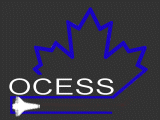Rockets: Students are given a presentation on
the origins of rocketry, its usefulness, and its future. An informal
presentation is also made on the shuttle program, its effect on space
research and exploration, and space-related technologies. Models and
hands-on activities are also conducted to enhance the learning experience.
Habitat: The students are shown around given a
tour of Spacesim's habitat, the Hawking. After the tour, they have the
chance to work at numerous stations set up inside. Each station presents
activities similar to those of a real astronaut, such as communicating with
Mission Control or performing a biomedical experiment.
Mission Control: Similar to their visit to
the Hawking, the students are given a tour of the Mission Control area.
Afterwards, they are given time to try out the equipment. For example, they
can talk with the students in the habitat via a modem or headsets, or they
can explore, through computer activities, the surface of the planets.
Newton's Laws: Students are introduced to
Newton's three laws of motion, the foundation of physics as we know it. The
laws are explained using amusing examples and demonstrated by the students
themselves.
Electrostatics: The students are given an
introduction to basic electromagnetic principles and theories, such as
static electricity, the concept of electrons, and charges in objects, and
how this science is relevent to their everyday
lives, aswell as space travel
Planets: The students are given a tour of the solar
system, similar to the one in Galactic tours. The students will get to
participate in hands-on demonstrations, and presentations which will give
them a basic knowlege of the Solar Bodies in our
solar system.
.jpg)

.jpg)
.jpg)
.jpg)
.jpg)